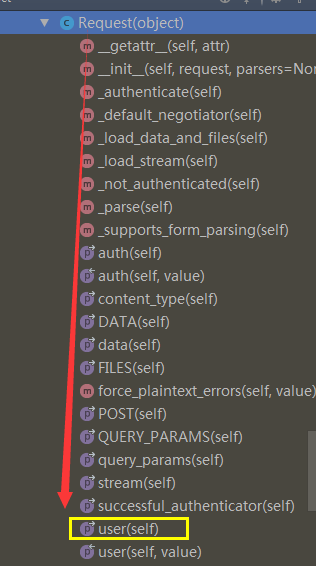Rest Framework 认证源码流程
一、请求到来之后,都要先执行dispatch方法,dispatch方法方法根据请求方式的不同触发get/post/put/delete等方法
注意,APIView中的dispatch方法有很多的功能
def dispatch(self, request, *args, **kwargs):
"""
`.dispatch()` is pretty much the same as Django's regular dispatch,
but with extra hooks for startup, finalize, and exception handling.
"""
self.args = args
self.kwargs = kwargs
第一步:对request进行加工(添加数据)
request = self.initialize_request(request, *args, **kwargs)
self.request = request
self.headers = self.default_response_headers # deprecate? try:
#第二步:
#处理版权信息
#认证
#权限
#请求用户进行访问频率的限制
self.initial(request, *args, **kwargs) # Get the appropriate handler method
if request.method.lower() in self.http_method_names:
handler = getattr(self, request.method.lower(),
self.http_method_not_allowed)
else:
handler = self.http_method_not_allowed # 第三步、执行:get/post/put/delete函数
response = handler(request, *args, **kwargs) except Exception as exc:
response = self.handle_exception(exc) #第四步、 对返回结果再次进行加工
self.response = self.finalize_response(request, response, *args, **kwargs)
return self.response
二、上面是大致步骤,下面我们来具体分析一下,看每个步骤中都具体干了什么事
1、对request进行加工(添加数据)
我们来看看request里面都添加了那些数据
a、首先 request = self.initialize_request(request, *args, **kwargs)点进去,会发现:在Request里面多加了四个,如下
def initialize_request(self, request, *args, **kwargs):
"""
Returns the initial request object.
"""
#请求弄成一个字典返回了
parser_context = self.get_parser_context(request) return Request(
request,
parsers=self.get_parsers(), #解析数据,默认的有三种方式,可点进去看
#self.get_authenticator优先找自己的,没有就找父类的
authenticators=self.get_authenticators(), #获取认证相关的所有类并实例化,传入request对象供Request使用
negotiator=self.get_content_negotiator(),
parser_context=parser_context
)
b、获取认证相关的类的具体 authenticators=self.get_authenticators(),
def get_authenticators(self):
"""
Instantiates and returns the list of authenticators that this view can use.
"""
#返回的是对象列表
return [auth() for auth in self.authentication_classes] #[SessionAuthentication,BaseAuthentication]
c、查看认证的类:self.authentication_classes
authentication_classes = api_settings.DEFAULT_AUTHENTICATION_CLASSES #默认的,如果自己有会优先执行直接的
d、接着走进api_settings
api_settings = APISettings(None, DEFAULTS, IMPORT_STRINGS) #点击继承的DEFAULTS类
DEFAULTS = {
# Base API policies
'DEFAULT_AUTHENTICATION_CLASSES': (
'rest_framework.authentication.SessionAuthentication', #这时候就找到了他默认认证的类了,可以导入看看
'rest_framework.authentication.BasicAuthentication'
),
e、导入了类看看类里面具体干了什么
from rest_framework.authentication import SessionAuthentication
from rest_framework.authentication import BaseAuthentication
f、看到里面有个authenticate方法和authenticate_header方法
class BaseAuthentication(object):
"""
All authentication classes should extend BaseAuthentication.
""" def authenticate(self, request):
"""
Authenticate the request and return a two-tuple of (user, token).
"""
raise NotImplementedError(".authenticate() must be overridden.") def authenticate_header(self, request):
"""
Return a string to be used as the value of the `WWW-Authenticate`
header in a `401 Unauthenticated` response, or `None` if the
authentication scheme should return `403 Permission Denied` responses.
"""
pass
具体处理认证,从headers里面能获取用户名和密码
class BasicAuthentication(BaseAuthentication):
"""
HTTP Basic authentication against username/password.
"""
www_authenticate_realm = 'api' def authenticate(self, request):
"""
Returns a `User` if a correct username and password have been supplied
using HTTP Basic authentication. Otherwise returns `None`.
"""
auth = get_authorization_header(request).split() if not auth or auth[0].lower() != b'basic':
return None #返回none不处理。让下一个处理 if len(auth) == 1:
msg = _('Invalid basic header. No credentials provided.')
raise exceptions.AuthenticationFailed(msg)
elif len(auth) > 2:
msg = _('Invalid basic header. Credentials string should not contain spaces.')
raise exceptions.AuthenticationFailed(msg) try:
auth_parts = base64.b64decode(auth[1]).decode(HTTP_HEADER_ENCODING).partition(':') #用partition切割冒号也包括
except (TypeError, UnicodeDecodeError, binascii.Error):
msg = _('Invalid basic header. Credentials not correctly base64 encoded.')
raise exceptions.AuthenticationFailed(msg) userid, password = auth_parts[0], auth_parts[2] # 返回用户和密码
return self.authenticate_credentials(userid, password, request) def authenticate_credentials(self, userid, password, request=None):
"""
Authenticate the userid and password against username and password
with optional request for context.
"""
credentials = {
get_user_model().USERNAME_FIELD: userid,
'password': password
}
user = authenticate(request=request, **credentials) if user is None:
raise exceptions.AuthenticationFailed(_('Invalid username/password.')) if not user.is_active:
raise exceptions.AuthenticationFailed(_('User inactive or deleted.')) return (user, None) def authenticate_header(self, request):
return 'Basic realm="%s"' % self.www_authenticate_realm
g、当然restfulframework默认定义了两个类。我们也可以自定制类,自己有就用自己的了,自己没有就去找父类的了,但是里面必须实现authenticate方法,不然会报错。
2、进行一下操作
- 处理版权信息
- 认证
- 权限
- 请求用户进行访问频率的限制
我们主要来看一下认证流程
认证流程:
a、首先 self.initial(request, *args, **kwargs)可以看到做了以下操作
def initial(self, request, *args, **kwargs):
"""
Runs anything that needs to occur prior to calling the method handler.
"""
self.format_kwarg = self.get_format_suffix(**kwargs) # Perform content negotiation and store the accepted info on the request
neg = self.perform_content_negotiation(request)
request.accepted_renderer, request.accepted_media_type = neg # Determine the API version, if versioning is in use.
#2.1 处理版本信息
version, scheme = self.determine_version(request, *args, **kwargs)
request.version, request.versioning_scheme = version, scheme # Ensure that the incoming request is permitted
#2.2 认证
self.perform_authentication(request)
# 2.3 权限
self.check_permissions(request)
# 2.4 请求用户进行访问频率的限制
self.check_throttles(request)
b、我们先来看认证,self.perform_authentication(request) 具体干了什么,按住ctrl点击进去
def perform_authentication(self, request):
"""
Perform authentication on the incoming request. Note that if you override this and simply 'pass', then authentication
will instead be performed lazily, the first time either
`request.user` or `request.auth` is accessed.
"""
request.user #执行request的user,这是的request已经是加工后的request了
c、那么我们可以从视图里面导入一下Request,找到request对象的user方法
from rest_framework.views import Request

@property
def user(self):
"""
Returns the user associated with the current request, as authenticated
by the authentication classes provided to the request.
"""
if not hasattr(self, '_user'):
with wrap_attributeerrors():
self._authenticate() #
return self._user #返回user
d、执行self._authenticate() 开始用户认证,如果验证成功后返回元组: (用户,用户Token)
def _authenticate(self):
"""
Attempt to authenticate the request using each authentication instance
in turn.
"""
#循环对象列表
for authenticator in self.authenticators:
try:
#执行每一个对象的authenticate 方法
user_auth_tuple = authenticator.authenticate(self)
except exceptions.APIException:
self._not_authenticated()
raise if user_auth_tuple is not None:
self._authenticator = authenticator
self.user, self.auth = user_auth_tuple #返回一个元组,user,和auth,赋给了self,
# 只要实例化Request,就会有一个request对象,就可以request.user,request.auth了
return self._not_authenticated()
e、在user_auth_tuple = authenticator.authenticate(self) 进行验证,如果验证成功,执行类里的authenticatie方法
f、如果用户没有认证成功:self._not_authenticated()
def _not_authenticated(self):
"""
Set authenticator, user & authtoken representing an unauthenticated request. Defaults are None, AnonymousUser & None.
"""
#如果跳过了所有认证,默认用户和Token和使用配置文件进行设置
self._authenticator = None # if api_settings.UNAUTHENTICATED_USER:
self.user = api_settings.UNAUTHENTICATED_USER() # 默认值为:匿名用户AnonymousUser
else:
self.user = None # None 表示跳过该认证 if api_settings.UNAUTHENTICATED_TOKEN:
self.auth = api_settings.UNAUTHENTICATED_TOKEN() # 默认值为:None
else:
self.auth = None # (user, token)
# 表示验证通过并设置用户名和Token;
# AuthenticationFailed异常
3、执行get/post/delete等方法
4、对返回结果在进行加工
Rest Framework 认证源码流程的更多相关文章
- restful framework 认证源码流程
一.请求到来之后,都要先执行dispatch方法,dispatch方法方法根据请求方式的不同触发get/post/put/delete等方法 注意,APIView中的dispatch方法有很多的功能 ...
- Django后端项目----restful framework 认证源码流程
一.请求到来之后,都要先执行dispatch方法,dispatch方法方法根据请求方式的不同触发get/post/put/delete等方法 注意,APIView中的dispatch方法有很多的功能 ...
- Django Rest Framework框架源码流程
在详细说django-rest-framework源码流程之前,先要知道什么是RESTFUL.REST API . RESTFUL是所有Web应用都应该遵守的架构设计指导原则. REST是Repres ...
- Django rest_framework 认证源码流程
一.请求到来后,都要先执行dispatch方法 dispatch根据请求方式的不同触发get/post/put/delete等方法 注意,APIView中的dispatch方法有很多的功能 def d ...
- Django drf:序列化增删改查、局部与全局钩子源码流程、认证源码分析、执行流程
一.序列化类的增.删.改.查 用drf的序列化组件 -定义一个类继承class BookSerializer(serializers.Serializer): -写字段,如果不指定source ...
- Flask 源码流程,上下文管理
源码流程 创建对象 from flask import Flask """ 1 实例化对象 app """ app = Flask(__na ...
- Django session 源码流程
流程 Django session源码流程 首先执行的是SessionMiddleware的init方法 import_module(settings.SESSION_ENGINE) 导入了一个 dj ...
- Shiro 登录认证源码详解
Shiro 登录认证源码详解 Apache Shiro 是一个强大且灵活的 Java 开源安全框架,拥有登录认证.授权管理.企业级会话管理和加密等功能,相比 Spring Security 来说要更加 ...
- ES6.3.2 index操作源码流程
ES 6.3.2 index 操作源码流程 client 发送请求 TransportBulkAction#doExecute(Task,BulkRequest,listener) 解析请求,是否要自 ...
随机推荐
- Flask ajax 动态html 的javascript 事件失效
$('.db_edit').click(function(){ $(".editdbproduct").val($(this).parent().parent().find('.e ...
- oracle objects - Materialized views and Synonyms
Materialized views - 物化视图,不实时查询表,定期更新,查询速度快 视图的更新频率我们可以在这看到:select * from dba_jobs , 一般在创建视图的时候完成的. ...
- react antd 动态表单
import React, { Component } from 'react'; import ReactDOM from 'react-dom'; import { Form, InputNumb ...
- tf随笔-6
import tensorflow as tfx=tf.constant([-0.2,0.5,43.98,-23.1,26.58])y=tf.clip_by_value(x,1e-10,1.0)ses ...
- 解放内存之搭建自己的 R Server
学校的课五门有四门需要跑R程序,有一些长长长的代码实在是占用了太多的内存,果断决定搭个R的服务器放着自己跑. 愉快的是,R studio server 的搭建真心简单快捷~这个从前被我忽略的东东终于排 ...
- PTA L3-023 计算图 (dfs+数学推导)
“计算图”(computational graph)是现代深度学习系统的基础执行引擎,提供了一种表示任意数学表达式的方法,例如用有向无环图表示的神经网络. 图中的节点表示基本操作或输入变量,边表示节点 ...
- C语言内存对齐对则
这篇文章讲的非常好 : http://blog.csdn.net/hairetz/article/details/4084088 用空间换时间, 规则 : 每个数据成员存储的起始位置都要是它的整数 ...
- QtAV的编译方法
1--编译准备 QtAV的安装编译总指导说明:https://github.com/wang-bin/QtAV/wiki/Build-QtAV QtAV的源代码:https://github.com/ ...
- 浪潮各机型管理芯片BMC IP(智能平台管理接口)设置
NF5240m3/NF5140m3/NF5280m3/SA5212H2/NP5540M3NF5270M3/NF5170M3/NF8420m3 IPMI主板集成管理芯片BMC IP 设置开机按DEL键进 ...
- SQL语句优化方法30例
1. /*+ALL_ROWS*/ 表明对语句块选择基于开销的优化方法,并获得最佳吞吐量,使资源消耗最小化. 例如: SELECT /*+ALL+_ROWS*/ EMP_NO,EMP_NAM,DAT_I ...
